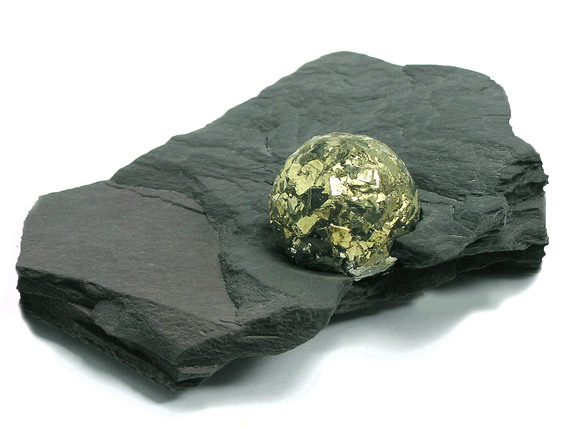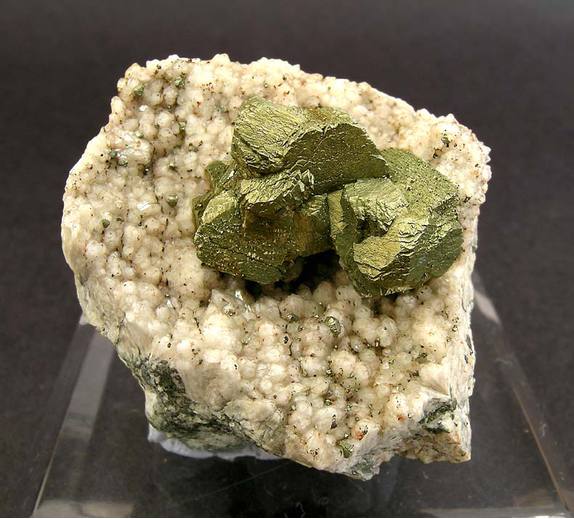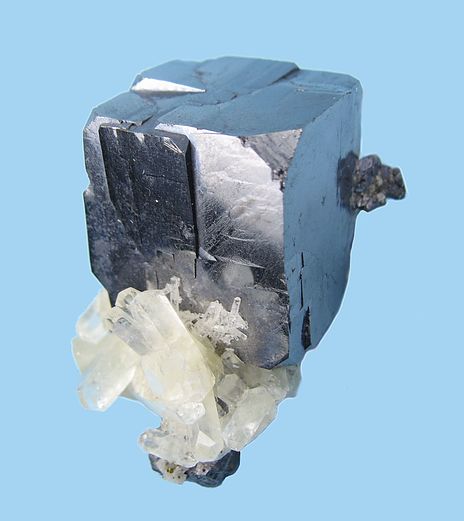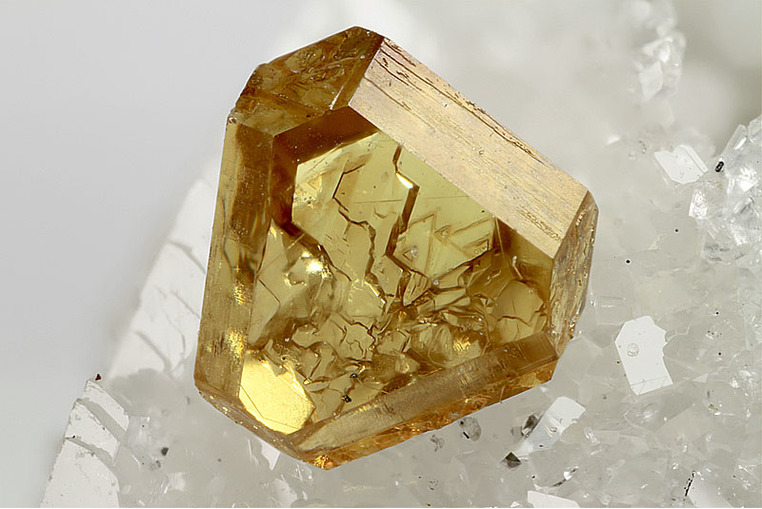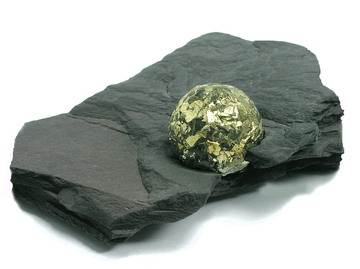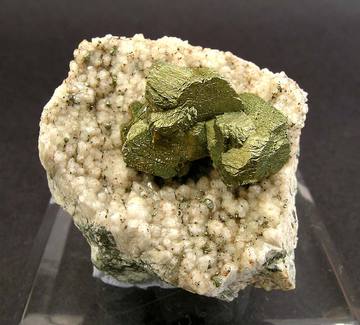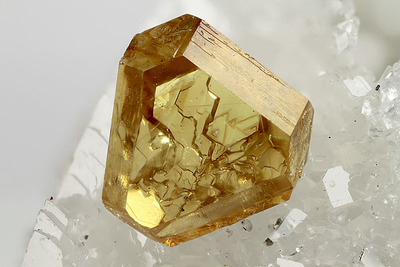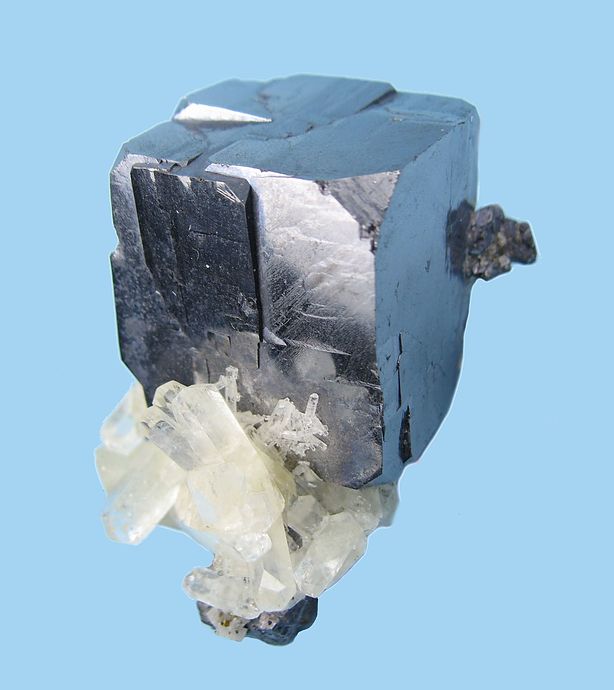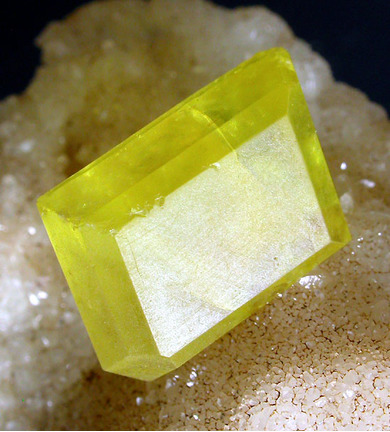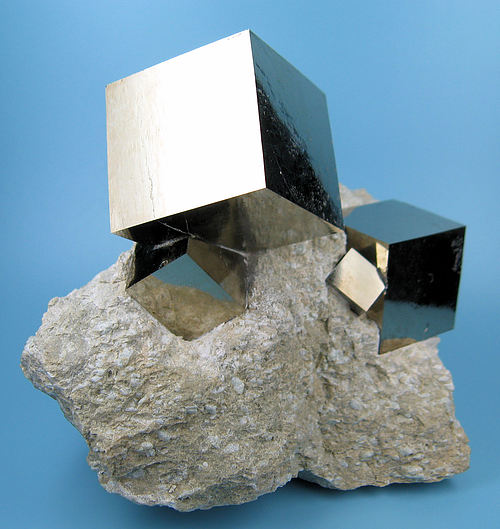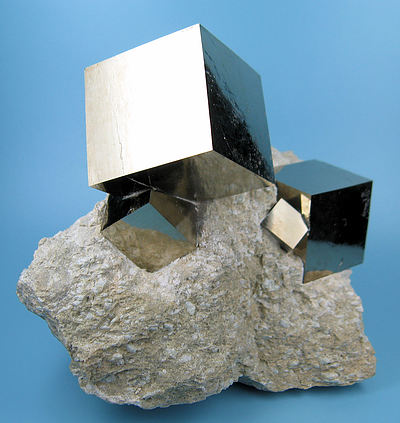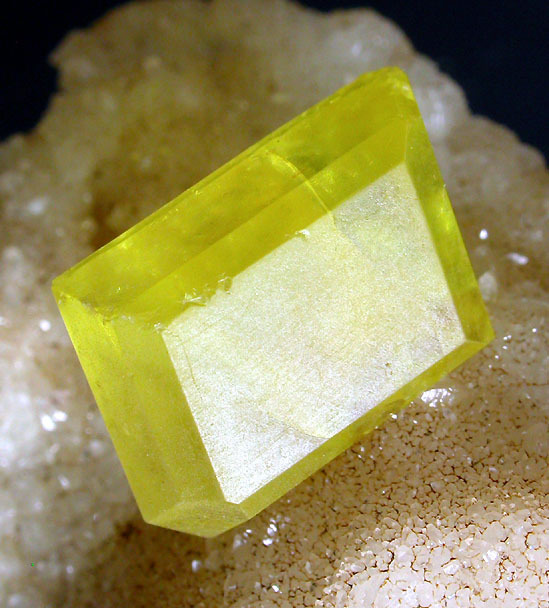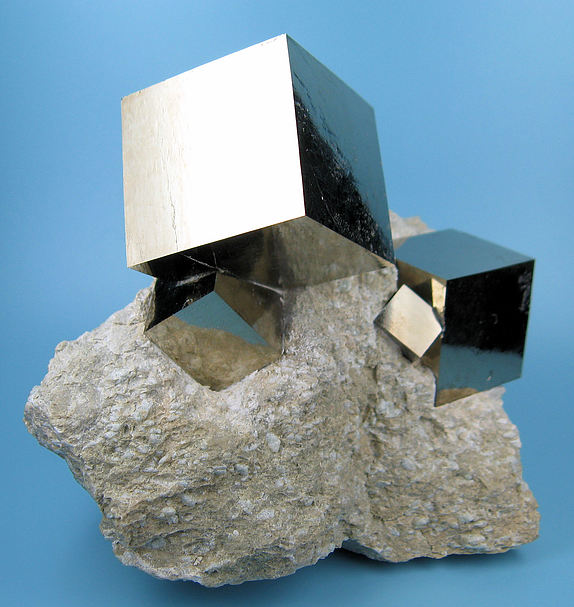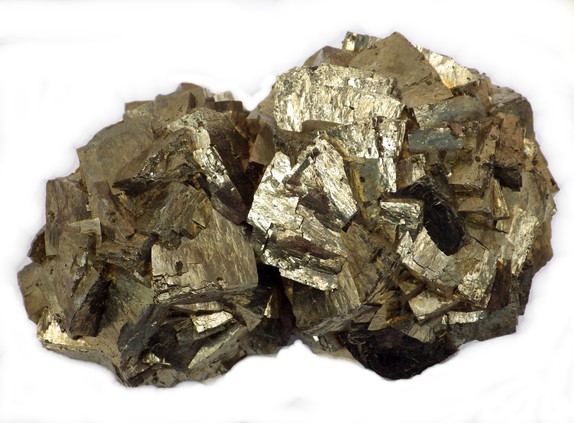The mineralogy of Sulfur
| General Properties | |
|---|---|
| Symbol: | S |
| Atomic Number: | 16 |
| Standard atomic weight (Ar): | 32.065(5) |
| Electron configuration: | [Ne] 3s2 3p4 |
| Photos | ||
|---|---|---|
| < | Sulphur - S8 | > |
| Atomic Properties | |
|---|---|
| Electronegativity (Pauling scale): | 2.58 |
| Atomic Radius: | 88 pm |
| Ionic Radius: | 184 pm (-2) |
| Van der Waals Radius: | 180 pm |
| 1st Ionization energy: | 1000 kJ/mol |
| 1st Electron affinity: | -200 kJ/mol |
| Oxidation States: | -2,-1,1,2,3,4,5,6 |
| Physical Properties | |
|---|---|
| Standard State: | solid |
| Bonding Type: | covalent network |
| Melting Point: | 388 K |
| Boiling Point: | 718 K |
| Density: | 1.96 g/cm3 |
| Metal/Non-Metal: | nonmetal |
| Main isotopes of Sulfur | ||||
|---|---|---|---|---|
| Isotope | % in Nature | Half Life | Decay type | Decay product |
| 32S | 95.02% | stable | ||
| 33S | 0.75% | stable | ||
| 34S | 4.21% | stable | ||
| 35S | synthetic | 87.32d | β− | 35Cl |
| 36S | 0.02% | stable | ||
| Main ions of Sulfur | ||||
|---|---|---|---|---|
| Name | Ion | Example minerals | ||
| sulfur(IV) | S4+ | |||
| sulfur(VI) | S6+ | |||
| sulfide | S2- | Galena, Sphalerite | ||
| disulfide | S22- | Pyrite, Marcasite | ||
| hydrogen sulfate (bisulfate) | HSO4- | |||
| hydrogen sulfite (bisulfite) | HSO3- | |||
| sulfate | SO42- | Gypsum, Baryte, Celestine, Anhydrite | ||
| sulfite | SO32- | |||
| thiosulfate | S2O32- | |||
| Other Information | |
|---|---|
| Year Discovered: | Ancient |
| Recognised as an element: | 1777 |
| Recognised By: | |
| Named For: | from the Latin word sulphurium: "to burn yellow" |
| CPK color coding: | #FFFF30 |
| External Links: | WikipediaWebElementsLos Alamos National LaboratoryTheodore Gray's PeriodicTable.com |
| Simple Compounds | |||||||||||||||||||||||||||||||||||||||||||||||||||||||||||||||||||||||||||||||||||||||||||||||||||||||||||||||||||||||||||||||||||||||||||||||||||||||
|---|---|---|---|---|---|---|---|---|---|---|---|---|---|---|---|---|---|---|---|---|---|---|---|---|---|---|---|---|---|---|---|---|---|---|---|---|---|---|---|---|---|---|---|---|---|---|---|---|---|---|---|---|---|---|---|---|---|---|---|---|---|---|---|---|---|---|---|---|---|---|---|---|---|---|---|---|---|---|---|---|---|---|---|---|---|---|---|---|---|---|---|---|---|---|---|---|---|---|---|---|---|---|---|---|---|---|---|---|---|---|---|---|---|---|---|---|---|---|---|---|---|---|---|---|---|---|---|---|---|---|---|---|---|---|---|---|---|---|---|---|---|---|---|---|---|---|---|---|---|---|---|
| Nitrides | tetrasulphur tetranitride | S4N4 | +3 | ||||||||||||||||||||||||||||||||||||||||||||||||||||||||||||||||||||||||||||||||||||||||||||||||||||||||||||||||||||||||||||||||||||||||||||||||||||
| Fluorides | sulfur difluoride | SF2 | +2 | ||||||||||||||||||||||||||||||||||||||||||||||||||||||||||||||||||||||||||||||||||||||||||||||||||||||||||||||||||||||||||||||||||||||||||||||||||||
| disufur difluoride | FSSF | +1 | |||||||||||||||||||||||||||||||||||||||||||||||||||||||||||||||||||||||||||||||||||||||||||||||||||||||||||||||||||||||||||||||||||||||||||||||||||||
| sulfur hexafluoride | SF6 | +6 | |||||||||||||||||||||||||||||||||||||||||||||||||||||||||||||||||||||||||||||||||||||||||||||||||||||||||||||||||||||||||||||||||||||||||||||||||||||
| sulfur tetrafluoride | SF4 | +4 | |||||||||||||||||||||||||||||||||||||||||||||||||||||||||||||||||||||||||||||||||||||||||||||||||||||||||||||||||||||||||||||||||||||||||||||||||||||
| disulfur decafluoride | S2F10 | +5 | |||||||||||||||||||||||||||||||||||||||||||||||||||||||||||||||||||||||||||||||||||||||||||||||||||||||||||||||||||||||||||||||||||||||||||||||||||||
| sulfur difluoride sulphide | SSF2 | +2,+4 | |||||||||||||||||||||||||||||||||||||||||||||||||||||||||||||||||||||||||||||||||||||||||||||||||||||||||||||||||||||||||||||||||||||||||||||||||||||
| Chlorides | sulfur dichloride | SCl2 | +2 | ||||||||||||||||||||||||||||||||||||||||||||||||||||||||||||||||||||||||||||||||||||||||||||||||||||||||||||||||||||||||||||||||||||||||||||||||||||
| disulfur dichloride | ClSSCl | +1 | |||||||||||||||||||||||||||||||||||||||||||||||||||||||||||||||||||||||||||||||||||||||||||||||||||||||||||||||||||||||||||||||||||||||||||||||||||||
| trisulfur dichloride | S3Cl2 | +1,+2 | |||||||||||||||||||||||||||||||||||||||||||||||||||||||||||||||||||||||||||||||||||||||||||||||||||||||||||||||||||||||||||||||||||||||||||||||||||||
| sulfur tetrachloride | SCl4 | +4 | |||||||||||||||||||||||||||||||||||||||||||||||||||||||||||||||||||||||||||||||||||||||||||||||||||||||||||||||||||||||||||||||||||||||||||||||||||||
| Iodides | disulfur diiodide | S2I2 | |||||||||||||||||||||||||||||||||||||||||||||||||||||||||||||||||||||||||||||||||||||||||||||||||||||||||||||||||||||||||||||||||||||||||||||||||||||
| Oxides | sulfur dioxide | SO2 | +4 | ||||||||||||||||||||||||||||||||||||||||||||||||||||||||||||||||||||||||||||||||||||||||||||||||||||||||||||||||||||||||||||||||||||||||||||||||||||
| sulfur trioxide | SO3 | +6 | |||||||||||||||||||||||||||||||||||||||||||||||||||||||||||||||||||||||||||||||||||||||||||||||||||||||||||||||||||||||||||||||||||||||||||||||||||||
| disulfur oxide | S2O | +1 | |||||||||||||||||||||||||||||||||||||||||||||||||||||||||||||||||||||||||||||||||||||||||||||||||||||||||||||||||||||||||||||||||||||||||||||||||||||
| disulfur dioxide | S2O2 | +3 | |||||||||||||||||||||||||||||||||||||||||||||||||||||||||||||||||||||||||||||||||||||||||||||||||||||||||||||||||||||||||||||||||||||||||||||||||||||
| Sulfur as a chromophore in minerals and gems | |
|---|---|
| Chromophore | Description |
| S3- | Blue colour of lazurite (according to Platonov et al, 1984) |
| S2- | Yellow hues in lazurite - green tones are a combination of S-3 and S-2. |
| SO4- | Ion radical also proposed as a source of blue coloration in lazurite (Samoilovich) |
| Mineral Diversity of Sulfur | |
|---|---|
| 1. Elements | 3 valid mineral species |
| 2. Sulfides And Sulfosalts | 645 valid mineral species |
| 3. Halides | 12 valid mineral species |
| 4. Oxides | 27 valid mineral species |
| 5. Carbonates | 15 valid mineral species |
| 6. Borates | 4 valid mineral species |
| 7. Sulfates | 495 valid mineral species |
| 8. Phosphates, Arsenates, Vanadates | 44 valid mineral species |
| 9. Silicates | 48 valid mineral species |
| 10. Organic Compounds | 6 valid mineral species |
| Total: | 1299 valid species containing essential Sulfur |
| Geochemistry of Sulfur | |
|---|---|
| Goldschmidt classification: | Chalcophile |
| S6+ is one of the eight most abundant solutes in average river water. | |
| S6+ solute can be a limiting nutrient in the growth of bacteria. | |
| S6+ solute is a macronutrient on land. | |
| S6+ is essential to nutrition of at least some vertebrates ('essential minerals'). | |
| S2- forms minerals with Cu+. | |
| S2- forms minerals with Ag+. | |
| Elemental Sulfur in Nature | ||
|---|---|---|
| Found as native element: | Sulphur | S8 |
| Elemental Abundance for Sulfur | ||
|---|---|---|
| Crust (CRC Handbook) | 3.50 x 10-4 | mass fraction, kg/kg |
| Crust (Kaye & Laby) | 3.0 x 10-4 | mass fraction, kg/kg |
| Crust (Greenwood) | 3.40 x 10-4 | mass fraction, kg/kg |
| Crust (Ahrens/Wänke) | 8.81 x 10-4 | mass fraction, kg/kg |
| Sea Water (CRC Handbook) | 9.05 x 10-4 | mass per volume fraction, kg/L |
| Sea Water (Kaye & Laby) | 9.0 x 10-4 | mass per volume fraction, kg/L |
| The Sun (Kaye & Laby) | 4.5 x 10-1 | atom mole fraction relative to Si=1 |
| Solar System (Kaye & Laby) | 5.2 x 10-1 | atom mole fraction relative to Si=1 |
| Solar System (Ahrens) | 5.15 x 10-1 (13%) | atom mole fraction relative to Si=1 (% uncertainty) |
| Element association of Sulfur in the Mineral World | |||
|---|---|---|---|
| This table compares the known valid mineral species listed listed with Sulfur and the other elements listed based on the official IMA formula. Note that unlike other sections on this page this includes non-essential elements. The first data column contains the total number of minerals listed with Sulfur and the element listed for that row. The second data column lists this number as a percentage of all minerals listed with Sulfur. The final data column compares this percentage against the percentage of all minerals that contain the element listed in each row. Click on a heading to sort. |
| Periodic Table | |||||||||||||||||||||||||||||||||||||||||||||||||||||||||||||||||||||||||||||||||||||||||||||||||||||||||||||||||||||||||||||||||||||||||||||||||||||||
|---|---|---|---|---|---|---|---|---|---|---|---|---|---|---|---|---|---|---|---|---|---|---|---|---|---|---|---|---|---|---|---|---|---|---|---|---|---|---|---|---|---|---|---|---|---|---|---|---|---|---|---|---|---|---|---|---|---|---|---|---|---|---|---|---|---|---|---|---|---|---|---|---|---|---|---|---|---|---|---|---|---|---|---|---|---|---|---|---|---|---|---|---|---|---|---|---|---|---|---|---|---|---|---|---|---|---|---|---|---|---|---|---|---|---|---|---|---|---|---|---|---|---|---|---|---|---|---|---|---|---|---|---|---|---|---|---|---|---|---|---|---|---|---|---|---|---|---|---|---|---|---|
| |||||||||||||||||||||||||||||||||||||||||||||||||||||||||||||||||||||||||||||||||||||||||||||||||||||||||||||||||||||||||||||||||||||||||||||||||||||||
| Phosphorus << Sulfur >> Chlorine | |||||||||||||||||||||||||||||||||||||||||||||||||||||||||||||||||||||||||||||||||||||||||||||||||||||||||||||||||||||||||||||||||||||||||||||||||||||||
| Most widespread minerals containing Sulfur | |||
|---|---|---|---|
| This list of minerals containing Sulfur is built from the mindat.org locality database. This is based on the number of localities entered for mineral species and is therefore slanted towards minerals interesting to collectors with less coverage of common rock-forming-minerals so it does not give an undistorted distribution of Sulfur mineral species. It is more useful when comparing rare species rather than common species. |
| Name | Formula | Crystal System | Mindat Localities |
|---|---|---|---|
| Pyrite | FeS2 | Isometric | 46621 |
| Chalcopyrite | CuFeS2 | Tetragonal | 31928 |
| Galena | PbS | Isometric | 28753 |
| Sphalerite | ZnS | Isometric | 25279 |
| Baryte | BaSO4 | Orthorhombic | 13934 |
| Pyrrhotite | Fe1-xS | Monoclinic | 10942 |
| Arsenopyrite | FeAsS | Monoclinic | 10676 |
| Gypsum | CaSO4 · 2H2O | Monoclinic | 8528 |
| Molybdenite | MoS2 | Hexagonal | 6851 |
| Marcasite | FeS2 | Orthorhombic | 6705 |
| Photos |
|---|
| Localities with greatest number of different Sulfur mineral species |
|---|
| Important ores of Sulfur | ||
|---|---|---|
| Most sulphur is produced by desulfurization of petroleum products and cleaning of sulfur from smelting smokestack, but some sulfur is produced from roasting pyrite FeS2 and native sulphur is still mined in some parts of the world. |
| Name | Formula | Crystal System |
|---|---|---|
| Sulphur | S8 | Orthorhombic |
| Pyrite | FeS2 | Isometric |
| Photos |
|---|
Spotted a mistake/omission? - These pages are a work in progress, so please send all comments/corrections to jolyon@mindat.org. Thank you.
Constants and physical property data from:
David R. Lide (ed.), CRC Handbook of Chemistry and Physics, 85th Edition. CRC Press. Boca Raton, Florida (2005).
Kaye and Laby Tables of Physical & Chemical Constants (2005). Section 3.1.3, Abundances of the elements
A. Earnshaw, N. Greenwood, Chemistry of the Elements, 2nd edition, Butterworth-Heinemann, (1997)
Thomas J. Ahrens (ed.), Global Earth Physics : A Handbook of Physical Constants, American Geophysical Union (1995)
L.B. Railsback, An Earth Scientist's Periodic Table of the Elements and Their Ions : Geology 31:9 p737-740 (2003)
Emsley, J. Nature's Building Blocks: An A-Z Guide to the Elements. New York: Oxford University Press (2001)









